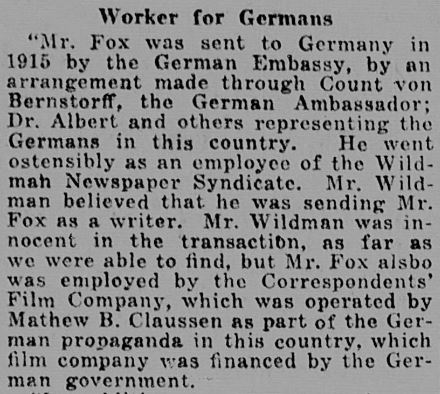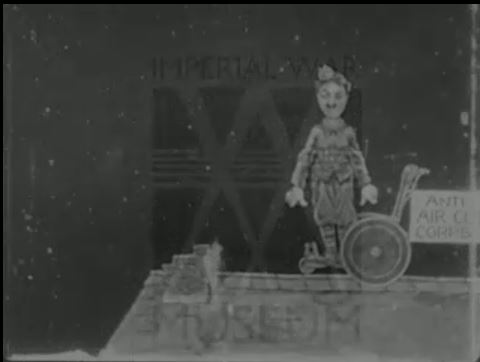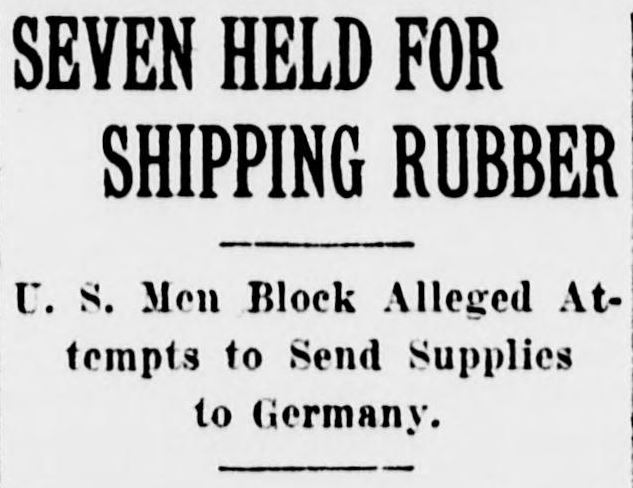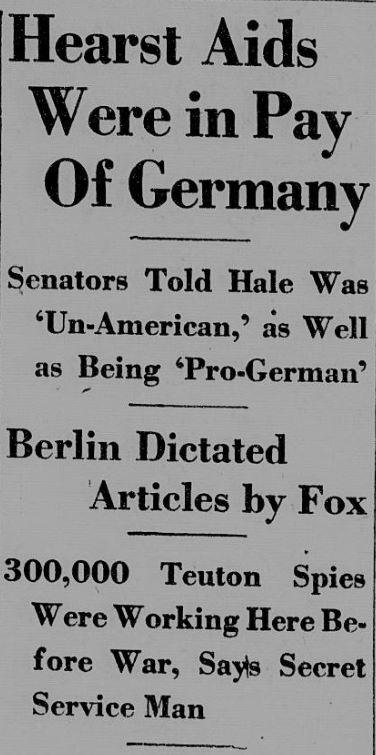 |
| Scottish Film Archive |
This post is part of the World War One in Classic Film Blogathon hosted by Lea at Silent-ology and Fritzi at Movies Silently. Be sure to click on most images to see larger versions.
Propaganda films are movies that are made to convince viewers of an idea or to affect their attitude or behavior. During wartime, they may be directed at the people of the country producing the movie, or at the people of neutral countries. It is difficult but not impossible to direct them at people of enemy countries.
As early as 1899, the Edison company produced "Raising Old Glory Over Morro Castle." "From
The Phonoscope, January 1899, p. 15: Down goes the Spanish flag, and up floats the Stars and Stripes. Down falls the symbol of tyranny and oppression that has ruled in the new world for four hundred years, and up goes the Banner of Freedom. In the distance are the turrets and battlements of Morro, the last foothold of Spain in America. (C. Musser,
Edison Motion Pictures 1890-1900, p. 482)" I'm not positive, but I believe the movie refers to the Morro Castle in San Juan, Puerto Rico rather than the one in Havana, Cuba. I think this short film is more boastful nationalism than propaganda, since the film wasn't made until after the conclusion of the Spanish-American War. Needless to say, it was not produced in Puerto Rico or Cuba.
British companies produced some actualities during the Second Boer War, but they don't seem to have been intended to do more than stir feelings of patriotism. Here we see the Gordon Highlanders leaving for the war, probably in 1899. The producer is unknown.
I supposed someone may have made films during the two Balkans Wars in 1912 and 1913, but I have never read of them.
The First World War was, I believe, the first war where governments actively used film as propaganda.
 |
| Moving Picture World, 15-August-1914 |
I would like to learn more about the Kaiser Film Company of 110 West 40th Street, New York City. There was a large audience of German-Americans who would have wanted to see this. It seems that many people admired "The Man of the Hour, Kaiser William II." It would be interesting to learn more about The Kaiser Film Company, which distributed this movie during the first month of the war.
 |
| Moving Picture World, 05-April-1913 |
Of course the Kaiser Film Company could have been recycling this movie, released by The True Feature Company the year before.
 |
| Moving Picture World, 11-December-1915 |
The German and Austrian governments surreptitiously set up the American-Correspondent Film Company in New York as a front organization to spread films intended to influence the American public to support the Central Powers or at least stay out of the war.
The Warring Millions, a six-reeler
, shows the results of American photographer Alfred K Dawson being allowed to follow the German Army on the Eastern Front as it besieged and conquered the Russian fortress of Ivangorod.
 |
| Moving Picture World, 04-December-1915 |
I guess it wasn't a secret that
The Warring Millions was propaganda, since this item says it was "a German war propaganda subject..."
The Battle Cry of Peace was a Vitagraph movie about American pacifists being used as dupes by foreign enemies.
 |
| Moving Picture News 07-August-1915 |
American-Correspondent President MB Claussen later ran into legal difficulties because of his involvement with the Germans and Austrians.
 |
| Moving Picture News 07-August-1915 |
 |
| Moving Picture News 14-August-1915 |
The American-Correspondent people knew that the fastest way to a reporter's/reviewer's heart is through his stomach. I like this: "'The Battle and Fall of Przemysl' (pronounce it to suit yourself)..." Everyone knows it is pronounced "sheh-mih-shul." ;0)
 |
| Moving Picture News 14-August-1915 |
"Mr Dawson has given us such a wide variety of scenes that an appalling idea of the monstrous proportions of modern international strife is embodied in the picture." The movie was shipped with a script for a lecture by Edward Lyell Fox, who accompanied German and Austrian armies and wrote a book called
Behind the Scenes in Warring Germany.
 |
| Moving Picture News 14-August-1915 |
 |
| Moving Picture News 21-August-1915 |
Someone must have complained about the propaganda content of the American-Correspondent pictures because they began to insist that their films " are strictly neutral... They ... deal with the war strictly on a fair and impartial basis."
 |
| Moving Picture News 11-September-1915 |
This story reports that Gustave Malitz, Vice-President and General Manager of American-Correspondent felt compelled to answer an article which had appeared in the 15-August-1915
New York World. Malitz "issues a denial of his alleged activities in behalf of the German government by the exhibition of war pictures supposed to favor the cause of the Central Empires..." He said he never hid the fact that these were official war pictures, and pointed out that American-Correspondent made and issued other types of movies besides war pictures.
 |
| Moving Picture News 18-September-1915 |
A week later, Moving Picture News said that they made a mistake. His name wasn't Gustave, it was Felix Malitz. They may confused him with Gustave Engler, the secretary of the company.
 |
| Moving Picture News 24-September-1915 |
"The NEUTRALITY of our Feature is wholly evidenced by the cordial exception of A. K. Dawson our Correspondent at the American Embassy in Berlin..."
 |
New York Sun, 04-May-1914
|
"A Federal jury in Brooklyn yesterday found Felix Malitz and Gustave Engler, president and secretary of the American Correspondents Film Company...guilty of smuggling rubber goods...in violation of the customs laws." These items were transshipped to Germany, violating the blockade.
 |
| New York Tribune, 14-December-1918 |
People who hate William Randolph Hearst will enjoy these bits from a story in the
New York Tribune, which was not a Hearst newspaper. The story claims that Hearst's newspapers and Hearst himself were involved in spreading German propaganda before America entered the war. Edward Lyell Fox is called an unreliable reporter who pushed the Central Power side. It mentions Fox's association with the American-Correspondent Film Company and MB Claussen "as part of the German propaganda in this country, which film company was financed by the German government."
 |
| Moving Picture News, 22-June-1916 |
The British were also interested in influencing American public opinion, first to support the Entente, the alliance of Britain, France and Russia, and then to enter the war on their side. Britain's War Propaganda Bureau, known as Wellington House, produced two feature films,
How Britain Prepared and
The Battle of the Somme.
 |
| Moving Picture News, 08-July-1916 |
The Patriot Film Company (good name) handled distribution on a states' rights basis. "I do not think that any film has been so well received by the critics since
The Birth of a Nation." That sounds like something the general manager would say.
 |
| Motography, 22-July-1916 |
This article says that the Patriot Film company planned to release the film on a road show basis (a limited number of theaters in big cities, lots of hype), but had decided to go states' rights to get the film distributed more widely more quickly.
 |
| Moving Picture World, 02-December-1916 |
The Battle of the Somme lasted from July to November 1916. More than one million soldiers were killed or wounded. Geoffrey Malins and John McDowell made a feature-length documentary which was released in Britain in August, 1916, while the battle was still raging. The Patriot Film Company brought it to the United States. It still exists.
This purports to be the whole
Battle of the Somme on YouTube. I haven't gotten to watch it yet. I don't know how long it will be there.
Wellington House found that making features took too long and cost too much money, so they devoted most of their effort for the rest of the war to producing short subjects.
 |
| Scottish Film Archive |
The Ministry of Food made "Patriotic Porkers" in 1918 to convince people about the proper way to raise pigs. "Save your Potato Peelings, Cabbage Leaves, Household Refuse, & c, to feed Pigs. All the Pigs in this Picture have been reared on Household Waste of this description." More pigs would mean more food for the people at home and the boys in the trenches. "HOUSEHOLD WASTE. Save it and breed Pigs; Collect it and feed Pigs; Use it to beat Pigs - The ones in Germany."
You can watch "Patriotic Porkers" at the Scottish Film Archive:
http://ssa.nls.uk/film/2995
 |
| Imperial War Museums |
"John Bull's Animated Sketchbook No 15" was released in July, 1916. It uses cut-out animations to make fun of the Germans and execute some horrible puns. Here we see an "Exclusive view of the countless prisoners captured by the Germans at Verdun." An endless line of soldiers marches by in the background. The next shot shows a fat German cranking an endless belt to create the illusion of many prisoners. This encourages people not to believe German reports.
 |
| Imperial War Museums |
"Zeppelin reconnoitering over Greece" has a fly buzzing over a pot of drippings (grease).
 |
| Imperial War Museums |
Three German soldiers sneak out into No Man's Land at night. One looks like the fat soldier who was cranking the display. "Last night we gained three metres. -- Berlin" They return carrying stolen gas meters.
 |
| Imperial War Museums |
A Zeppelin flies over London. A soldier who resembles Charlie Chaplin appears on a rooftop. He looks at a newspaper and reads the names of Russian victories. These cause the Zeppelin to crash. Charlie takes a bow.
You can watch "John Bull's Animated Sketchbook No 15" at the Imperial War Museums:
http://www.iwm.org.uk/collections/item/object/1060000205
The United States joined the war in April, 1917. Learning from the British, the United States put its propaganda efforts into the hands of one organization, the Committee on Public Information, also called the Creel Committee, after its chairman, George Creel.
 |
| Moving Picture News, 22-June-1918 |
The Creel Committee produced a few features. The first was
Pershing's Crusaders. "
Pershing's Crusaders was taken by the U.S. Signal Corps and Navy Photographers and the French General Staff."
 |
| Moving Picture News, 29-June-1918 |
"The First Official War Film."
 |
| Moving Picture News, 29-June-1918 |
The Creel Committee also made short subjects.
The Allied Nations Official War Review was a series of one-reelers. "This reel gives the authentic, live, up-to-date war news that the American public wants to see."
 |
| Moving Picture World, 13-July-1918 |
Hollywood producers did their part to help Americans hate Germany. Where Kaiser Bill had been "The Man of the Hour" in 1914, now he was "The Beast of Berlin." Lon Chaney played German Chancellor Theobald von Bethmann-Hollweg. ."No Picture like it in the Whole World's Market." No kidding.
 |
| Moving Picture News, 29-June-1918 |
A little less subtle than
The Kaiser, Beast of Berlin was
To Hell With the Kaiser. Note the Kaiser being punched in the last item. In World War II there was a popular tradition of comic book covers where Hitler got punched. "Shows what every American wants to see, the truth naked and undraped...Capturing the unspeakable monster of the world, the Kaiser, with a fleet of American Aeroplanes."
The most famous American propaganda movie of the war is "The Bond," a one-reeler produced and paid for by Charlie Chaplin. It was intended to encourage people to buy Liberty Bonds to support the war effort. His war movie, "Shoulder Arms," didn't premier until after the Armistice which ended the war.
The print is a little dark, but be sure to stay and see Charlie's smile at the very end.
I first read about "The Bond" many years ago, probably in the filmgraphy at the end of Chaplin's
My Autobiography. I did not know it was one of a large group of such films starring many Hollywood luminaries including Sessue Hayakawa, Mary Pickford and Roscoe Arbuckle.
This post is part of the World War One in Classic Film Blogathon hosted by Lea at Silent-ology and Fritzi at Movies Silently. Thank you to Lea and Fritzi for all the hard work. Thank you to everyone who visited and I encourage you to read as many posts as you can, and leave comments. Bloggers love comments.























































A wonderful, comprehensive post and such a great choice for this blogathon. These kind of 'public service' films are often overlooked which is a shame as there's a lot to gain from them and it puts a lot of Hollywood in context. Thank you for sharing!
ReplyDelete"HOUSEHOLD WASTE. Save it and breed Pigs; Collect it and feed Pigs; Use it to beat Pigs - The ones in Germany." Tell us how you really feel! ;-)
ReplyDeleteGreat selection of clippings and clips. They seem exaggerated in hindsight but I wonder what everyone will think of our films in a century? Wonderful post, as always.
girlsdofilm -- Thank you for the kind words. I was going to more of the short public service-type films when I discovered a reference to the American-Correspondent Film Company. I got tangled up there.
ReplyDeleteFritizi: Wasn't that a great intertitle? It may have been too subtle for some people. I imagine people in the future will look at things like Fox New and wonder what we were thinking. I'm glad you enjoyed it.
Wow! What a great post! Thoroughly enjoyed it. I feel like I've been to a WWI/Film Studies class. Thank you! :)
ReplyDeleteGee, thank you for the kind words. I had fun writing it. I've always been interested in World War One. I'm enjoying all the posts and learning a lot from them.
ReplyDeleteWow, Joe, you did a great job! I'm sure your took a lot of time to do this research and I learned a lot with it!
ReplyDeleteVery interesting to see the battle before the US entered the war: the fights about who was making propaganda for which country and disobeying blockades. Also, thanks for pointing the short film The Bond. I hadn't heard about it until now.
Thanks for the kind comment.
Greetings!
Thanks, Lê. I'm glad you learned from it. There were battles to get many of the neutral countries -- the US, Argentina, Chile -- to join on one side or the other. The Bond is fun. You can probably find a better copy on YouTube somewhere.
ReplyDelete